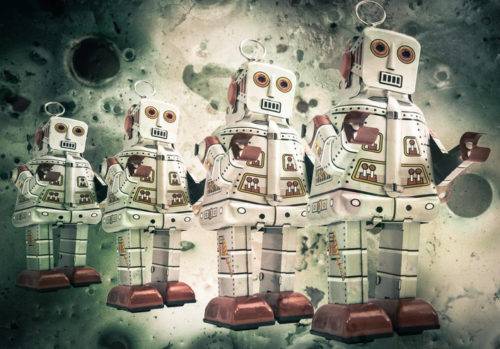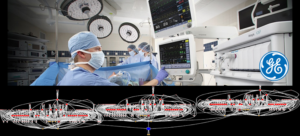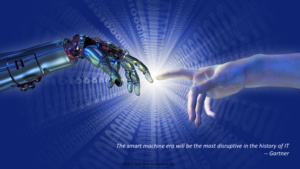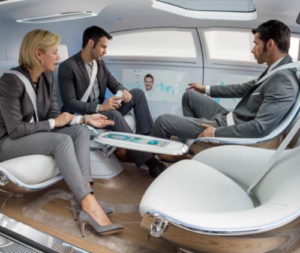The other day, my 13-year old brought home a not-so-great report card. I wanted to motivate him to do better, so I asked, “What do you want to do with your life?”
He looked up at me. Then, he looked down at our dog, sleeping contentedly on the floor. He looked back at me, and said, “Dad, I want to be a pet of the robot overlords.”
I was floored. Say what? This is my legacy? This is his ambition?
See also: How the lack of interoperability standards could be killing IoT
Then I realized…throughout history, those who do best leverage the technology of the day. He plans to specifically leverage smart machines? That’s not a bad career ambition at all. Being a pet is smart. Being a good pet is brilliant.
Your children will not drive. Your children will not write. Your children will not compose music. Your children will not make buying decisions. Or, at least they will not have to. There are already intelligent computing systems challenging human capabilities in all these areas.
And, assuming Moore’s law continues as it has, computers in 40 years will not be 10x better than today. Or 100x. Or 1000x. Computers will be a mind-boggling 4 million times better than today. Any statement that “humans will always do X better than machines” is blatant, ignorant bio-supremacy.
So, we will all be pets of the robot overlords. That’s good, because they will make the world much better.
Paging smart hospitals & healthcare
Consider medical care in hospitals. Shockingly, hospital error is the 3rd leading cause of death in the U.S. Today’s devices don’t talk to each other. They don’t even know they are connected to the same patient.
This system is not good enough. Without the ability to check readings between devices, it’s hard to differentiate a nuisance alarm from a life-threatening condition. Simple mistakes happen in hundreds of ways. For instance, every heart-bypass surgical team that Harvard Medical School surveyed made the same disastrous mistake at least once: forgetting to resume ventilation after disconnecting the heart-lung machine. Patient-controlled analgesia, the system that allows thousands of patients to self-administer morphine after a surgery, is widely used and considered safe. But, it still kills 2-3 patients a day.
There are just far too many failure modes for harried hospital staff to do this on their own.
The smart machine disruption will change all that. By connecting devices together and adding “doctor in a box” smart software, most all these errors will be history. And, it’s already happening! GE Healthcare, for instance, is building a system capable of handling 200,000 connected devices in a 1200 bed hospital. It will be deployed soon.
Connecting smart energy
The environment will also benefit. Our current power grid handles only one-way power flow. Big generators produce power that flows to distributed loads in neighborhoods and companies. There hasn’t been a major disruption since the advent of 3-phase transmission in the 1930’s. But it’s clear: the future power grid must incorporate distributed renewables like solar and wind.
How? It’s not that simple. Big spinning-metal generators cannot change their output faster than about 15 minutes. So, centralized controllers tell them to generate enough power to cover the expected load over the next 15-minute period. They have to add a small margin of “spinning reserves”, because if the generation ever drops below the load, the grid can fail completely.
Solar adds generation capacity, but clouds can cover entire neighborhoods in minutes or even seconds. The big spinning generators can’t react that fast, so the central controller must increase spinning reserves. Unfortunately, spinning those reserves burns nearly as much oil or coal as the no-solar original system. So, most solar energy is simply wasted.
The solution? Just like the medical case, connect the devices and add intelligent software. In this case, the software wraps local control loops around the solar cells and a little local battery storage. Even 15 minutes of storage smooths the fast bumps and allows the generators to reduce reserves.
This also is already happening. Duke Energy, the largest US utility, leads an effort called “OpenFMB” design to transform the grid. Dozens of companies are cooperating to build an implementation. Intelligent, distributed control will soon sweep the industry, bringing much greener energy and much better efficiency.
Driving toward smart transportation
These are great, but medicine and power are not even the greatest disruptions. That distinction goes to “driverless cars”. Autonomous cars are more like robots on wheels than an evolution of cars. For these reasons, I will refer to them as “carbots.” There is a drastically new player in our lives and a new player deserves a new name.
The benefits are many and profound. By eliminating the cause of 94% of accidents, Carbots will purge the road carnage from our society. Time wasted today can be used to sleep or work. Carbots can drive in close, efficient formation, saving energy and time, and making good use of today’s carpool lanes. Because we don’t need to store carbots near you, we can turn urban parking lots into parks. They will make extensive travel practical for millions. They will clear DUIs from our courts. They will bestow freedom of motion on those who can’t drive. They will disrupt nearly every aspect of daily life, all of it for the better.
Of course, carbots will also disrupt the 30% of US jobs directly related to driving. These include the obvious: truckers, delivery people, and Uber drivers. The greater effects will eliminate roadside hotels, revolutionize elder and child care, obsolete auto insurance, and do away with auto-body shops. Driverless cars will impact our economy and society more than anything since the horseless carriage.
In the end, smart machines will make our world better…much better. Your children may not drive, write, compose music, or make buying decisions. But, they will live in a cleaner, healthier, safer, world. The smart machine era will be liberating in ways we can never imagine today.
So, what will people do? That’s a great question, which is of course unanswerable. Even if you knew the answer, nobody would understand it. This is not new; if you went back in time to 1975, you could never explain what a backend SaaS engineer did at LinkedIn. The future will bring unknowable companies and jobs.
We do know one thing: the world will be much more efficient. The analysts differ on the positive impact on the economy, but they all agree on the magnitude: trillions. The smart machine era will be a multi-trillion-dollar feast.
So, how can you best survive and thrive? Don’t be a bio supremacist. Like my son, embrace the robot overlords. Seek a way to leverage the technology. Find your link to things that think.
Dr. Stan Schneider is CEO of Real-Time Innovations (RTI), the Industrial Internet of Things (IIoT) connectivity platform company with an extensive footprint in all areas of the IIoT including Energy, Medical, Automotive, Transportation, Defense, and Industrial Control. Schneider is also the small company representative on the Industrial Internet Consortium (IIC) Steering Committee and serves on the advisory boards for Smart Industry and IoT Solutions World Congress. Embedded Computing Design Magazine presented Stan the Top Embedded Innovator Award for 2015. Stan holds a BS and MS from the University of Michigan and a PhD in Electrical Engineering and Computer Science from Stanford University.












